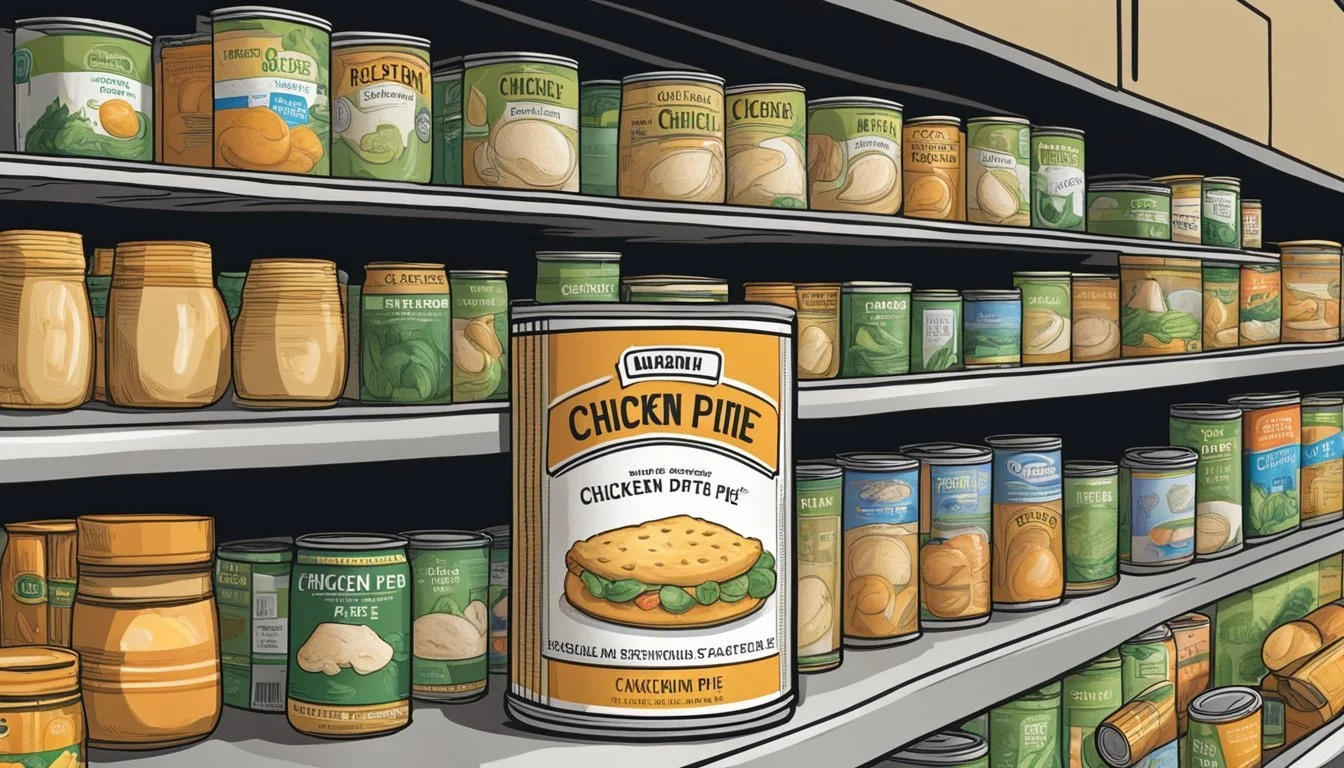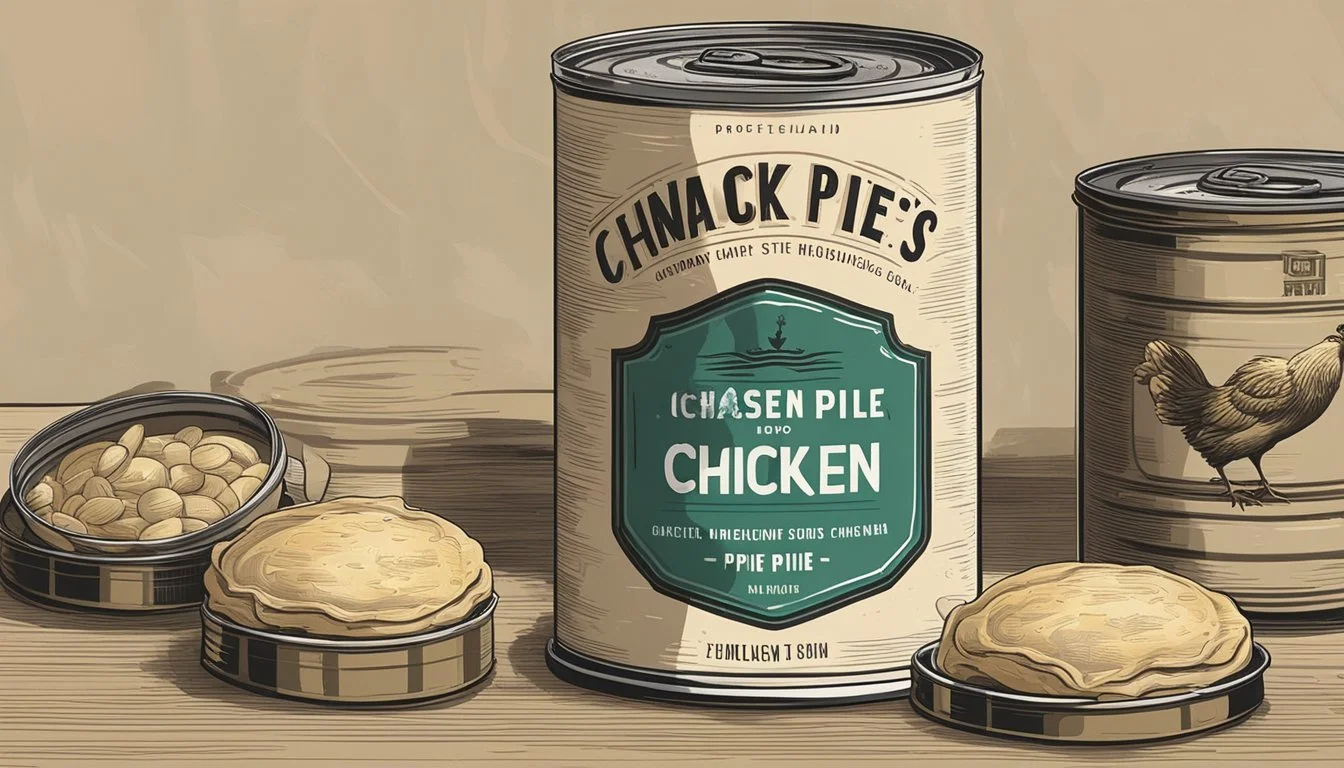Does Canned Chicken Pot Pie Expire?
Essential Shelf Life Facts
Canned chicken pot pie does indeed have an expiration date, but that doesn't mean the contents are instantly unsafe to eat once that date passes. Generally, canned chicken can be safely consumed for up to 3-5 years after the expiration date, as the canning process preserves the food by heating it to a high temperature and sealing it to prevent bacterial growth. However, it's crucial to check for signs of spoilage such as a bulging or swollen can.
Canned foods offer convenience and a reliable source of nutrition, making them a popular choice for many households. The extended shelf life of canned chicken pot pie ensures that this savory meal remains accessible, whether you're stocking up for an emergency or just keeping your pantry well-supplied.
Despite its longevity, always inspect the can before use. If the can appears damaged or compromised in any way, it's best to err on the side of caution and discard it. This simple precaution can help ensure that your meals remain safe and enjoyable.
Understanding Canned Chicken Pot Pie
Canned chicken pot pie marries the convenience of canned foods with the comfort of a hearty, homemade dish. This section will explore the core elements that make up a chicken pot pie and provide insights into the basics of canned foods, including shelf life and quality aspects.
Components of a Chicken Pot Pie
A chicken pot pie typically consists of a flaky pie crust, a savory filling of meat (usually chicken), and a variety of vegetables. Essential veggies often include carrots, peas, corn, and potatoes. The filling also incorporates a creamy base, often made from a roux, broth, and sometimes milk or cream.
When made using canned chicken, the preparation is streamlined. The chicken is pre-cooked and ready to mix directly with the other ingredients. The pie crust covers the filling before baking, creating a golden, crispy exterior that contrasts with the creamy, hearty filling inside. Potatoes, carrots, and other veggies are sometimes also available canned, further reducing prep time.
The Basics of Canned Foods
Canned foods are preserved through a process that involves heating and sealing the food in airtight containers. This method ensures a long shelf life. Low-acid canned goods, such as canned chicken, can remain shelf-stable for years if stored properly.
However, it’s important to monitor the integrity of the can. Any signs of rust, bulging, or leakage indicate that the food may no longer be safe. Some users report a slight metallic taste in canned chicken, but this can often be minimized by rinsing. The extended shelf life makes canned items dependable pantry items and reduces food waste.
Safety and Expiration
Canned chicken pot pie, like many other canned foods, has a specific expiration date indicating peak quality. Understanding the shelf life and recognizing signs of spoilage is crucial for ensuring safety.
Determining the Shelf Life
Canned chicken pot pie typically has a long shelf life due to the canning process. This involves heating the contents to high temperatures to kill bacteria and sealing the can to prevent recontamination.
Expiration dates provided by manufacturers indicate the period during which the product is at its best quality. Eating it after this date may be safe but is not recommended. "Best By," "Use By," and "Sell By" dates are quality indicators, not safety dates.
Proper storage conditions also affect the shelf life. Cans should be stored in cool, dry places to avoid rust or damage.
Recognizing Signs of Spoilage
Identifying spoilage in canned chicken pot pie is essential for safety. There are several key signs to look for:
Bulging or Swollen Cans: This indicates bacterial growth or fermentation.
Unpleasant or Off Odors: A bad smell upon opening the can is a clear sign the food is spoiled.
Unusual Taste or Texture: Any changes in taste or a mushy texture should prompt discarding the product.
Leakage or Rust: Visible damage to the can may compromise its contents.
Always err on the side of caution and discard any cans exhibiting these signs to prevent foodborne illness.
Storage and Preservation
Proper storage and preservation of chicken pot pie ensure its safety and quality. Key factors include temperature control, airtight containers, and freezing to extend shelf life.
Proper Storage Conditions
The freshness of chicken pot pie is influenced by storage methods and ingredients used. Cooling the pot pie to room temperature before refrigerating helps maintain its texture and flavor. It should be stored in an airtight container to prevent contamination and drying out.
For best results, it should be kept in the refrigerator at or below 40°F (4°C). When prepared with dairy or eggs, the shelf life in the fridge typically ranges from 3 to 5 days. Using these methods reduces food waste and maintains food safety.
Extending Pot Pie Life
Freezing is an effective way to extend the life of chicken pot pie. To freeze, wrap the pot pie tightly in plastic wrap or foil, and place it in a freezer-safe container. When properly stored, frozen chicken pot pie can last up to 2 to 6 months.
Labeling the container with the date helps keep track of its shelf life. To reheat, it should be thawed in the refrigerator overnight and then warmed in an oven to ensure even heating. These practices ensure that leftovers are consumed safely and efficiently.
Using canned foods, including chicken, can further extend a pot pie's longevity. Items made with canned vegetables or chicken have a more extended shelf life compared to fresh ingredients when refrigerated. Combining these approaches helps in reducing food waste and maintaining the quality of the dish.
Preparation and Usage
Canned chicken pot pie offers a convenient and quick meal option. Efficient preparation and versatile use can help achieve delicious results every time.
Cooking the Perfect Pot Pie
To cook the perfect pot pie, start by preparing your ingredients. Drain the canned chicken and mix it with cream of chicken soup, mixed vegetables, and milk. For a richer flavor, add seasonings like thyme or rosemary.
Preheat the oven to 400°F (about 200°C). Place a bottom pie crust into a pie pan and spray with non-stick spray. Pour the chicken mixture evenly over the crust.
Cover with another pie crust, then pierce the top with a knife or fork to allow steam to escape. Crimp the edges to seal everything. Bake for about 30-35 minutes or until golden brown. Let it cool slightly before serving to maintain a good texture.
Creative Uses for Canned Pot Pie
Canned chicken pot pie can also be used creatively. For leftovers, consider transforming them into casseroles. Simply layer the pot pie with mashed potatoes or pull apart the crust to mix with extra veggies and bake.
In addition to being a main dish, the filling can be used in chicken salad, adding mayonnaise, celery, and grapes for a twist. Or make a buffalo chicken dip by mixing with hot sauce and cheese, then baking.
These creative uses not only minimize waste but also provide varied meal options to keep your dinners exciting and delicious.
Nutritional Considerations
Canned chicken pot pie offers both convenience and a variety of nutrients, but it also comes with some considerations regarding ingredient quality and health impacts.
Analyzing the Ingredient List
The primary components of canned chicken pot pie typically include chicken breast, broth, vegetables, and dairy products such as heavy cream or cream of chicken soup.
Chicken Breast: This is a good source of lean protein. Canned versions may contain added preservatives or sodium.
Broth: Often used to create the base of the pie, broth provides flavor and moisture, but can be high in sodium.
Vegetables: Canned versions may include carrots, peas, and celery. Canned veggies often have lower nutrient content compared to fresh vegetables.
Dairy: Ingredients like cream or butter add richness but also increase the calorie and fat content.
Health Benefits and Risks
Health Benefits:
Protein: Chicken breast provides essential protein, beneficial for muscle maintenance.
Convenience: Using canned and pre-shredded options like chunk chicken or shredded chicken simplifies meal prep.
Versatility: Suitable for a quick family meal with a nutritionally balanced profile.
Health Risks:
Sodium Levels: Products like broth and canned chicken can be high in sodium. Excessive sodium intake may lead to health issues such as high blood pressure.
Fat Content: The inclusion of heavy cream or cream of chicken soup increases the dish's saturated fat content, which should be consumed in moderation.
Nutrient Density: Canned veggies are often less nutrient-dense than their fresh counterparts, leading to a potential deficit in vitamins and minerals.
Understanding these nutritional aspects can help in making informed choices regarding canned chicken pot pie.
Regulatory and Industry Standards
Regulatory and industry standards ensure canned chicken pot pie is produced and labeled safely and accurately. Key points include understanding food labeling, date codes, and safety protocols during manufacturing.
Food Labeling and Date Codes
The USDA sets stringent guidelines for food labeling to maintain public health. Labels must clearly indicate the expiration date or best-by date, informing consumers about the expected shelf life.
Date codes help track a product's viability. For canned chicken pot pie, this may appear as a "Best By" or "Use By" date. This label ensures product quality, though canned food can sometimes remain safe for consumption past these dates if stored properly.
Manufacturers follow the USDA’s guidelines to prevent bacteria growth, enhancing consumer safety. Mislabeling or omitting expiration dates can lead to regulatory actions and recalls, underscoring the importance of accurate labeling.
Manufacturing and Safety Protocols
Safety protocols in canned food production aim at preventing contamination and ensuring long shelf life. Vacuum sealing is crucial, removing air to inhibit microbial growth.
Manufacturers must comply with USDA standards, regularly inspecting facilities and equipment. This ensures that every can of chicken pot pie meets safety benchmarks.
The production process includes thorough cooking and sterilization. This kills most pathogens, ensuring the canned chicken remains safe until the stated expiration date. Additionally, recalled products, like the example from Aunt Kitty's Foods Inc., demonstrate the system’s effectiveness in consumer protection.
Alternative Options
Several alternatives to canned chicken pot pie exist, focusing on freshness and homemade methods. Some key points include choosing between homemade and canned versions and the advantages of utilizing fresh ingredients.
Homemade vs. Canned Pot Pie
Homemade chicken pot pie offers more control over the ingredients. This choice allows for the inclusion of fresh vegetables like green beans, carrots, and peas, making it healthier. The use of poultry instead of canned chicken can enhance flavor and texture.
Additionally, applying an egg wash to the homemade crust ensures a golden, appealing finish. While canned options provide convenience and consistency, they often contain preservatives. Homemade pies eliminate these, providing a fresher, more wholesome meal.
Utilizing Fresh Ingredients
Using fresh vegetables and herbs can significantly improve the taste and nutritional value of a chicken pot pie. Frozen mixed vegetables offer a convenient compromise, still superior to canned.
Fresh ingredients like herbs and quality poultry elevate the recipe, creating more vibrant flavors. Opt for a freshly made or homemade crust over a canned or pre-made one for better taste and texture. Incorporating fresh ingredients means fewer additives and preservatives, contributing to a healthier dish.








